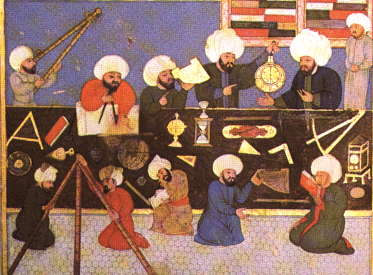
Time Reckoning
Era means a definite space of time, reckoned from the beginning of some past year, in which either a prophet, with signs and wonders, and with a proof of his divine mission, was sent, or a great and powerful king rose, or in which a nation perished by a universal destructive deluge, or by a violent earthquake and the sinking of the earth, or a sweeping pestilence, or by intense drought, or in which a change of dynasty or religion took place, or any grand event of the celestial and the famous tellurian miraculous occurrences, which do not happen save at long intervals and at times far distant from each other. Al-Bîrûnî (1879:16)
Time is relative. Given the modern world’s reliance on formalized calendars and machines that define time for us, it is easy to forget that the expansion of Islam occurred at a time when telling time was not dependent on a formal science of astronomy. How time is measured is not only a practical issue but also reflective of the desired interval of duration and the precision in defining it. Simple observation of the sun rising and setting, as well as its location, can easily yield calendars to determining hours, days, months and years. Similarly, the moon’s phases made it a useful measure for the Islamic lunar calendar. Observations of movements by the stars, as well as the planets, also provided practical ways of measuring units of time both short and long.
The 13th century North African scholar Ibn al-Ajdâbî (1964:28) began his treatise on time reckoning (hisâb al-azmina) with the claim that all known peoples use four basic time divisions: hour, day, month, year. The hour (sâ‘a) is the division of day and night into 24 equal divisions. This in fact assumes knowledge of a formal calendrical system, since there was nothing in direct observation of the sun to mandate such a division. The day (yawm) comprises daytime (nahâr) and nighttime (layl), an obvious universal distinction. While other peoples started the day at dawn, Ibn al-Ajdâbî notes that the Arab Bedouins began the day at sunset. This use of “Arab†time is still found throughout the region (for example, rural Yemen) alongside the standard reckoning. According to al-Bîrûnî (1979:5), the Arabs did this because their months were based on the phases of the moon, which become visible towards sunset. The month (shahr) could be either sidereal or synoptic, the latter regulating the Islamic lunar calendar. The year was defined by the basic seasonal change over the course of twelve months.
Our understanding of how ordinary Arabs at the beginning of Islam measured time is complicated by references in the texts that refer both to formal astronomical reckonings, which were not necessarily widely known or used, with folk knowledge. Ibn Qutayba (1956:1-3) states that the traditional Bedouin Arabs of the peninsula did not divide up the year according to the formal four-season model of the astronomers, but rather from what they knew locally about the timing of hot and cold weather, and the presence and disappearance of plants and pasture. Thus, he notes, they began their year with the autumn rain called rabı‘, followed by a sequence of recognized rain periods. Other Arabs were said to separate the year into two parts: shitâ’, which is male because of the rain in it, and sayf, which is female because of the pasture. The clear message is that telling time seasonally was adapted to local contexts and reflected a symbolism of natural fertility. A major problem in reconstructing such local seasonal systems with any degree of specificity is that the terms used may refer to different times or seasons from one system to another. Added to this is the general lack of information as to which tribe or group used a particular seasonal reckoning system.
Comparative ethnographic findings suggest that how people reckon time is contextual to their needs as well as other systems they may have been exposed to. Arab pastoralists and farmers would have been primarily interested in seasonal patterns of weather, as we see reflected in the anwâ’ genre discussed below. Sailors would have been more interested in weather patterns that influenced the ability to sail and the presence of favorable winds. Fishermen and pearl divers would have their own interests, merchants and rulers theirs. Thus, we should not expect to find a discrete set of folk astronomical systems as we have come to expect from the formal science of astronomy. As Islam spread, Muslims would follow their own local traditions, adapt those of others with whom they came in contact, and build on the evolving literature of the religion and science.
What makes the folk astronomy of Islamic peoples “Islamic†is not simply that people were now Muslim. Reckoning time in the practical sense now took on an added dimension of a historical time frame in which the God of Abraham, Moses, Jesus and Muhammad dealt with the world. This Islamic rendering of history built on Judaism and Christianity, starting with the creation of Adam, and also covered the evolving Islamic polity of the caliphate, dynasties, military and missionary expansion. Not surprisingly, the eras of relevance to Muslims were at times defined according to astronomical events. The God who created sun, moon and stars for time-keeping purposes was also perceived as sending signs for Muslims to interpret and metaphors for a better appreciation of what Islam should mean for the believer.
References
al-Bîrûnî, Abû al-Rayhân Muhammad. The Chronology of Ancient Nations (al-Athâr al-bâqiya). Translated by C. E. Sachau. London: W. H. Allen, 1879.
Ibn al-Ajdâbî. Kitâb al-Azmina wa-al-anwâ’. Damascus: Wizârat al-Thaqâfa wa-al-Irshâd al-Qawmî, 1964.
Ibn Qutayba, Abû Muhammad ‘Abd Allâh. Kitâb al-Anwâ’. Hyderabad: Matba‘at Majlis Dâ’irat al-Ma‘ârif al-‘Uthmânîya, 1956.
Excerpt from Daniel Martin Varisco. Islamic Folk Astronomy, In The History of Non-Western Astronomy. Astronomy Across Cultures, pp. 615-650. Edited by Helaine Selin. Dordrecht: Kluwer Academic Publishers, 2000.
For Part 1, click here.